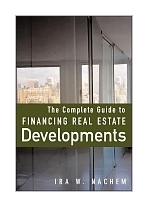The Completee Guide to Financing Real Estate Developments
offers a detailed roadmap to navigate the complex process of financing small to
large-scale real estate projects, such as office buildings, apartment complexes, and
hotels.
Real estate expert Ira Nachem explores the pros and cons of large versus small
institutions; how to structure and present a loan proposal, the approval and closing
processes; the truth about appraisals, guarantees, insurance and lien law; financial and
physical bonuses and constraints, environmental issues and many other topics.
Nachem presents in-depth information and explanations that answers questions
on:
- Who the Commercial Real Estate Lender Really Is
- What Information Should the Borrower Produce
- How a Workable Budget is Created
- How the Lender Evaluates a Borrower
- What the True Value of an Appraisal Is
- What goes into a Lender's Loan Presentation
- What to Expect at a Closing
- What Key Legal Documents are Most Important
- What the True Value of a Guarantee Is
- How the Borrower and Lender Prepare for the Funding Process
- What Is involved in Loan Administration After the Closing
- What Is the View from the Borrower's Perspective
- What Are some of the Constraints and Incentives to Development
- What Are the Values and Risks of Insurance and Bonding
- What Is the Reason for Title Insurance and how does it work
- What Are the Complexities of Lien Law and how does it work
- How Is the Loan Eventually Repaid
- What Real Estate Math Is Essential for the Professional
- How Important Are Environmental Issues
- How Can the Lender Find New Loan Prospects
- What Are the Risks and Rewards of Loan Participations
Featuring a wide range of helpful examples and illustrations, The Complete Guide
to Financing Real Estate Developments covers many of the day-to-day realities faced in the
real estate industry including the differing perspectives of lenders and borrowers, their
personal pressures, personalities and politics, and much more.
Ira W. Nachem has over 25 years of commercial real estate experience in finance,
investment, development, construction and management. His executive positions in real
estate banking, development, management and brokerage have given him direct involvement in
all kinds of credit and equity transactions collateralized by all types of properties
throughout the United States. He currently lectures on real estate and construction
finance at New York University.
Table of Contents
Preface
Chapter I: The Commercial Real Estate Lender
Chapter II: The Borrower's Information
Chapter III : Budgeting
Chapter IV: Evaluating the Borrower
Chapter V: Appraisals
Chapter VI:The Loan Presentation
Chapter VII: The Lender's Closings, Legal Documents and Guarantees
Chapter VIII: Preparing for the Funding Process
Chapter IX: Loan Mechanics After Closing
Chapter X: Project Completion
Chapter XI: View From Borrower's Perspective
Chapter XII: Constraints and Incentives to Development
Chapter XIII: Insurance and Bonding
Chapter XIV: Title Insurance and Lien Law
Chapter XV: Loan Repayment
Chapter XVI: Real Estate Math
Chapter XVII: Pricing
Chapter XVIII: Environmental Concerns
Chapter XIX: Marketing/Searching For Loan Prospects
Chapter XX: Loan Participations
Chapter XXI: Problems and Issues
About the Author
450 pages, Hardcover


